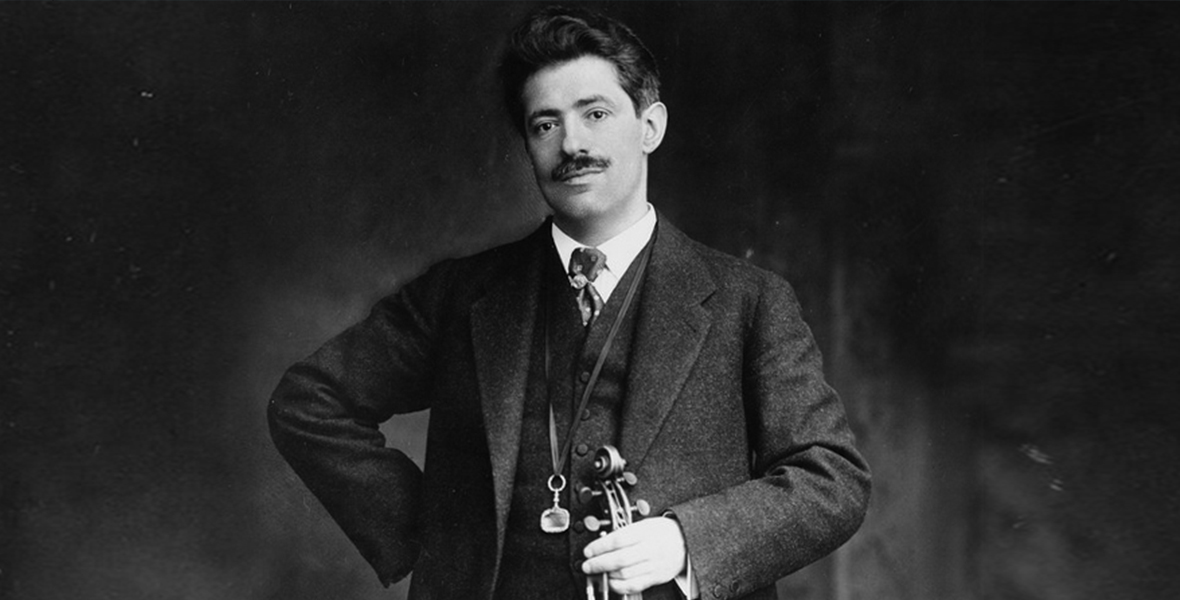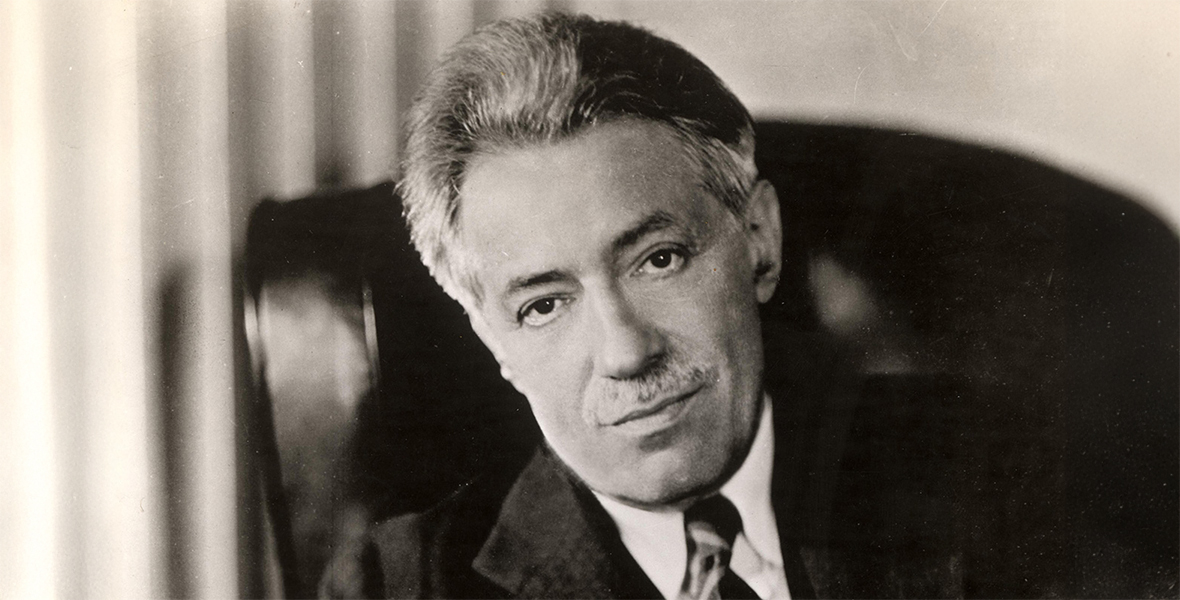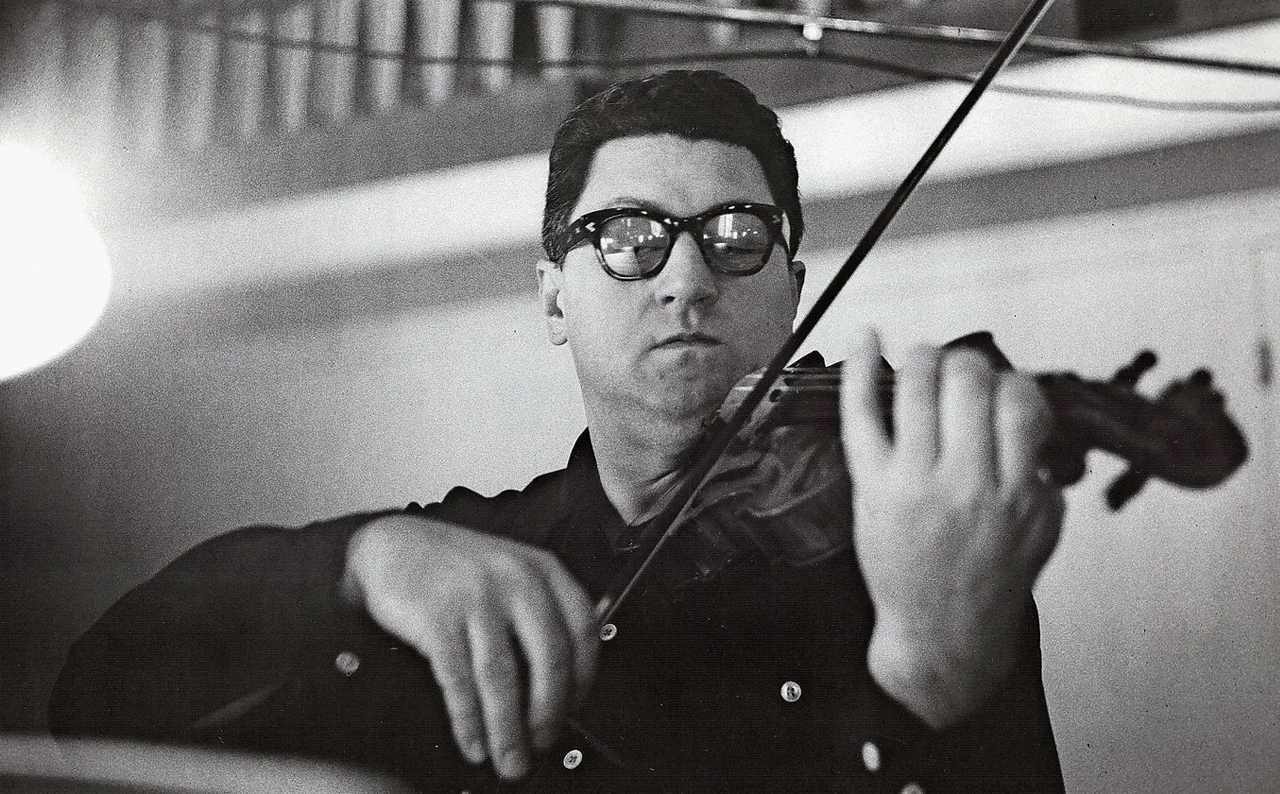THE COMPETITION HISTORY
Austria’s most important violin competition dates back to the prize that Fritz Kreisler privately donated every year, before 1938, for the best violin student at the Vienna Music Academy. 1979 saw the year that the competition became international, where violinists of all nationalities were able to compete on the centre stage. Yehudi Menuhin was on the jury at this time. Since 1979, the International Fritz Kreisler Society typically organizes the International Fritz Kreisler Violin Competition every four years at the Vienna Musikverein or the Vienna Konzerthaus.
As one of the largest international violin competitions – established in 1979 by Wolfgang Schneiderhan and managed by Michael Frischenschlager since 1989 – the Fritz Kreisler International Competition, which to date has taken place nine times, is a source of attraction for young violinists from all over the world and is an event through which the City of Vienna pays tribute to one of its great artists and musicians.
Fritz Kreisler Violin Competition - Short chronology
1932-38 • The ‘Fritz Kreisler Competition’, as it was originally known, was an internal violin competition organized every year by the Vienna Music Academy — today the University of Music and Performing Arts — for the violin students. The first prize, donated by Kreisler, was given to the best violin student of the year.
1956 • Formative meeting between the young violin student from Salzburg, Michael Frischenschlager (19), with Fritz Kreisler (81) in New York.
1975 • On the occasion of a commemorative concert organized by Prof. Frischenschlager at the Vienna Music University, the idea arises together with Prof. Wolfgang Schneiderhan and Prof. Franz Samohyl to establish an international Fritz Kreisler Competition in Vienna.
1979 • I. International Fritz Kreisler Violin Competition. It successfully takes place on the 10th to the 19th of September in the Vienna Musikverein with Yehudi Menuhin as a jury member, Prof. Wolfgang Schneiderhan as President, and Prof. Franz Samohyl as Vice-president.
1983 • II. International Fritz Kreisler Violin Competition. The competition takes place again in the Vienna Musikverein. Unfortunately, it ends with a large deficit of over 2 million Schillings. This means that — despite its successful debut — the Fritz Kreisler Competition had to wait until 1992 to mark its return.
1984-88 • Irmgard Seefried and Wolfgang Schneiderhan convince the City of Vienna and the bank Creditanstalt Bankverein to pay off the debts. Prof. Schneiderhan asks Prof. Frischenschlager to become his successor and to rebuild the competition. He resigns as President and becomes an Honorary President.
1989-91 • Frischenschlager prepares to resume the competition by looking for sponsors, PR, and organizing promotional concerts. A Kreisler concert in the Café Central in Vienna, broadcast on the ORF television, Kreisler concerts in New York (Carnegie Hall, Chamber Music Hall) and Washington (Georgetown University) are such examples. Dr. Helmut Zilk — The Mayor of Vienna — welcomes the return of the competition.
1992 • III. International Fritz Kreisler Violin Competition. This time in the Vienna Konzerthaus. Gala-Final in the Great Hall with the Vienna Symphony Orchestra. At the end, the prize winners perform on Kreisler’s famous Guarneri violin (brought to Vienna from the Library of Congress in Washington with sponsorship from the Austrian National Bank). The ORF television broadcasts the Gala-Final. The primary funders are the City of Vienna and several Federal Ministries. The competition becomes part of the musical life in Vienna and thus, every four years, Vienna becomes the goal for the world’s best young violinists.
1996 • IV. International Fritz Kreisler Violin Competition. Now again in the Musikverein. Very high international participation. The Gala-Final is partially broadcast by ORF television. The Vienna City Councillor, Dr. Ursula Pasterk, presents the Fritz Kreisler Prize to the first prize winner. Due to Vienna’s strong musical heritage, the name of Fritz Kreisler, the prestigious venues (Vienna Konzerthaus, Vienna Musikverein) and to the innovative programme and jury rules, the competition becomes one of the favourite, most-subscribed international violin competitions. Prestigious cooperation partners include: the Vienna Philharmonic Orchestra, the Vienna Symphony Orchestra, the University of Music and Performing Arts, the Salzburg Festival, ORF, Naxos, Jeunesse-Musikalische Jugend.
2000 • V. International Fritz Kreisler Violin Competition. In the Vienna Konzerthaus. As always, the competition is highly successful with a large number of participants. The culture department of the City of Vienna can no longer finance the Gala-Final, instead the Gerber Foundation (Zurich) provide additional funding.
2005 • VI. International Fritz Kreisler Violin Competition. In the Vienna Konzerthaus. Again, a highly successful event. Due to the passing of Mrs. Gerber (President of the Gerber Foundation), the Swiss funding for the Gala-Final is no longer possible. Due to this large loss in income and many increased costs, there is once again a deficit.
2010 • VII. International Fritz Kreisler Violin Competition. In the Vienna Konzerthaus. The quality and success prove to be very high once again. Frischenschlager manages to increase the income from sponsors. But increased costs (Konzerthaus-halls rental, graphic design and printing costs and participants accommodation) once again unfortunately lead to a deficit.
2014 • VIII. International Fritz Kreisler Violin Competition. In the Vienna Konzerthaus. International participation remains high as well as the artistic level of the participants. A campaign subsidised by the Austrian Federal Ministry of Education enables many Viennese school pupils to attend the 19 concerts of the competition. Because of the continued diminishing income from sponsors, targeted savings are necessary through e.g., welcoming the participants into the homes of music-loving families of members of the Viennese Rotary Clubs.
2018 • IX. International Fritz Kreisler Violin Competition. Once again in the Vienna Musikverein. Preparation proceeded as usual but another dramatic decline of sponsorship and the unexpected loss of the traditional funding from the Viennese city government made cancellation seem inevitable. However when all hope seems lost, Klaus Heymann, President of NAXOS (Beijing) allows the competition to go ahead with his personal support. A main sponsor in China, KUKE MUSIC HOLDING Ltd, was also instrumental in the survival of the competition. Thus, the competition can take place successfully. The University of Music and Performing Arts held the first and second round for the first time and the semi-final, Final I and Gala-Final were also live streamed. The competition concludes without a deficit for the first time since 2000.
2022 • The X. International Fritz Kreisler Violin Competition. A jubilee and an anniversary — the 60th year after Kreisler’s passing. This means a renewed commitment to organizing the competition at the highest level and to honor the memory of Fritz Kreisler. During the year of the competition, there will be additional events such as concerts, an exhibition and a documentary film about his life.




Fritz Kreisler´s life - Short chronology
1875 • Born on 2 February in Vienna as the second of five children to a highly musical Jewish family that originated from Galicia.
1879 • First violin lessons at the age of 4. Fritz immediately exhibited spectacular musical talent.
1882 – 85 • Entry into the Vienna Conservatory as a child prodigy, pupil of Joseph Hellmesberger Junior and of Anton Bruckner. Sensational first public concerts. First composition as an 8-year old. Graduation with a Diploma and Gold Medal.
1885 – 87 • Continuation of his studies at the Paris Conservatory with Joseph Lambert Massart and Leo Delibes. 2 years later, graduation from his studies in Paris with the award of the Grand Premier Prix as by far the youngest student ever. This marked the end of Kreisler’s formal violin tuition. Return to Vienna.
1888 – 89 • Concert tour of the prodigy in the USA with 50 concerts together with the pianist Moritz Rosenthal.
1889 – 95 • Back to Vienna. The violin was put aside. His father insists that he attends the Piaristen secondary school. Matura (school leaving exam), military service as a 1-year volunteer in the Imperial and Royal Army, reserve officer. Short attempt to study medicine at the University of Vienna. Prof. Billroth urges him in the stongest terms to follow a career in music.
1896 – 98 • Return to music, to the violin. Unsuccessful audition for the orchestra of the Imperial and Royal Court Opera (Vienna Philharmonic Orchestra). Composition of the inspired cadenzas to Beethoven’s violin concerto and of the first, soon to be famous, short violin pieces in historical styles. First concert tours as a soloist (Greece, Turkey, Russia). A year and a half after the failed attempt to become a member of the Vienna Philharmonic Orchestra and after further successful concert tours (within the Hapsburg Empire, Germany), triumphant return to the Great Hall of the Musikverein as a soloist with the Vienna Philharmonic Orchestra under the baton of Hans Richter on 23 January 1898.
1899 – 1914 • Beginning of his world career. 1 December 1899, first concert with the Berlin Philharmonic under the baton of Arhur Nikisch. Ever more concert tours to all countries of Europe and the USA. 1902, marriage to Harriet Lies, the daughter of a New York tobacco wholesaler, who unconditionally supported her brilliant husband. Kreisler becomes a favourite of the public in all important concert halls around the world. 260 concerts per year. His compositions in historical styles, at first attributed to genuine old masters, as well as his Viennese melodies (Caprice Viennois, Fair Rosemary, Love’s Joy, etc.) are met with great acclaim.
1910 – 12 • 70,000 copies of his compositions sold in a year. Exclusive record contract with Victor in London.
1912 • Piano trio Kreisler, Harold, Bauer, Casals.
1914 – 18 • First world war. Kreisler fulfils his duty as a reserve lieutenant of the army of his fatherland and goes – accompanied by his wife, a nurse for the Red Cross – to the Russian front. He is wounded and recovers. Moves to New York. Start of his great charitable activities (benefit concerts, fundraising) for Austrian war orphans and widows. After the USA joined the war, forced end to his concert activity. Composition of his first Operetta “Apple Blossoms”. (Successful premiere, 1919 in New York). Composition of his string quartet in A minor.
1919 – 24 • Kreisler’s first concert after the war in Carnegie Hall in aid of starving children in Vienna. His worldwide career continues with overwhelming success. Concert tours to China, Japan, Korea. In the USA, there are repeated relief actions for Austria that was in dire need. 1921, triumphant comeback in London, 1924 also in Paris. Nearly all of Kreisler’s concerts in these years were for charitable causes. The Austrian government considers appointing Kreisler as Austrian Ambassador to the USA.
1925 – 38 • Kreisler is the most celebrated, highest paid violin virtuoso of his time. Moves back to Europe and buys a prestigious villa in Berlin. In addition to the usual tours in Europe and the USA, there are concert tours to the furthest flung continents (Australia, New Zealand, South America — to where he travelled in a Zeppelin). Creation of the Fritz Kreisler Prize for the best violin students of the Vienna Music Academy.
1932 • Premiere of Kreisler’s second Operetta “Sissy” in the Theater an der Wien with Paula Wessely and Hans Jaray as Sissy and Kaiser Franz Joseph, respectivley. Since 1933, Kreisler tried to prevent the discrimination of renowned Jewish artist colleagues in Berlin.
1935 • The City of Vienna celebrates Kreisler’s 60th birthday in the Townhall. The Mayor, Richard Schmitz, presents Kreisler with the Ring of Honour of his home city in the presence of dignitaries.
1939 – 45 • Kreisler refuses to accept an imposed German citizenship following the dissolution of Austria. His compositions are black-listed. He becomes an honorary citizen of France, leaves his Berlin residence and moves to New York, for the second time in his life, to the native country of his wife — this time for ever. Continued concert activity. 1941, there is a bad accident, Kreisler is runover by a lorry and seriously injured. 1943, composes his last compositions, again dedicated to his home city: “Viennese Rhapsodic Fantasietta”. Became a naturalised American citizen.
1945 • On his 70th birthday, Kreisler performs the Sibelius violin concerto at Carnegie Hall.
1945 – 62 • After the end of the war, the packages full of shoes, clothes, toys and medicines once again pile up at the collection points of aid organisations in Vienna and Berlin from Fritz and Harriet Kreisler. Gradual end to his concert activity following 60 years of unparalleled success.
1949 • Kreisler auctions his famous library (hand-written documents, early editions, first editions, incunabula) and donates the proceeds of ca. 1.5 milion euros in today’s equivalent value to the New York Lennox Hospital and the Golden Rule Foundation.
1952 • Kreisler gifts his entire personal music property to the Library of Congress, including valuable autograph manuscripts – for example, that of the Brahms violin concerto – and his favourite violin, that he played for more than 20 years, a Guarnerius del Gesù from 1733 – according to Hill the most beautiful Guarnerius that is still in existence today.
1955 • The musical world, Heads of State, Monarchs, artists and music institutions from all continents honour Kreisler on the occasion of his 80th birthday.
1962 • The life of the great Austrian violinist and composer, Kreisler, comes to an end on 29 January in New York.
FRITZ KREISLER
(Vienna, 1875 – 1962, New York)
Fritz Kreisler is regarded as one of the greatest violinists of all time. He was loved by audiences and revered by critics and colleagues. His long and colourful life was more worthy of a nineteenth-century novel, an epic story about a man who was a link between the nineteenth and twentieth centuries in music, went through two world wars, and lived up to the modern comforts of the 1960s.
Kreisler was born on February 2, 1875. He is wunderkind during his childhood (could read music when he was three), he became in 1882 the youngest student admitted to the Vienna Conservatory. At ten he won the Conservatory gold medal and transferred to the Paris Conservatoire. In 1887, at 12, he was awarded the Conservatory’s Premier Premier Prix. Kreisler’s United States debut was in New York City’s Steinway Hall on November 10, 1888. He continued to tour the U.S. until 1889. Back home, he applied and auditioned for a position in the Vienna Philharmonic Orchestra but was rejected. When he discovered that he did not receive a position in the orchestra, he thought of following his father’s profession and did two years’ medical training. In 1896 he decided on music and began his career as a travelling virtuoso. By World War I, in which he was conscripted, he served two stints in the Austrian army; he wounded in the leg and reported killed. Later he wrote a book about his military experience in Russia. He recalled: “I envisaged myself operating on a patient in the morning, playing chess in the afternoon, giving a concert in the evening, and winning a battle at midnight.”
As a child he met César Franck and Sigmund Freud. During his youth, he was part of Brahms’ outer circle. He used to perform with Sergej Rachmaninov, and got to know Bruch, Joachim, Wolf, Glazunov, Schoenberg.
In addition to being an outstanding performer, Kreisler wrote a considerable amount of music, including pieces for violin and piano, violin solo, operettas, a string quartet, and many cadenzas. The Beethoven D major violin concerto cadenza is the most popular among violinists, and his music for violin remains staples of classical concert life today.
From 1924 Kreisler made his home in Berlin. After the Anschluss of Austria in 1938, Kreisler took French citizenship. At the start of World War II, Kreisler moved to the United States, and in 1943 became a naturalized U.S. citizen. In 1941 he was hit by a truck and spend several weeks in coma, however, he recovered and continued to perform until 1950.
During his whole life, Fritz Kreisler was a philanthropist. During the II War he generously helped war orphans and refugees and played charity concerts. He was known for his charitable contributions, he donated money, manuscripts, and with his talent and music he helped to create a better world.
He died in January 1962.



